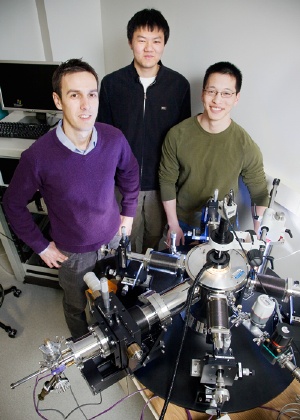Feb 9 2009
By pushing carbon nanotubes close to their breaking point, researchers at the University of Illinois have demonstrated a remarkable increase in the current-carrying capacity of the nanotubes, well beyond what was previously thought possible.
 Electrical and computer engineering professor Eric Pop, from left, worked with undergraduate Yang Zhao and graduate student Albert Liao, both in ECE, to demonstrate a remarkable increase in the current-carrying capacity of carbon nanotubes. Photo by L. Brian Stauffer.
Electrical and computer engineering professor Eric Pop, from left, worked with undergraduate Yang Zhao and graduate student Albert Liao, both in ECE, to demonstrate a remarkable increase in the current-carrying capacity of carbon nanotubes. Photo by L. Brian Stauffer.
The researchers drove semiconducting carbon nanotubes into an avalanche process that carries more electrons down more paths, similar to the way a multilane highway carries more traffic than a one-lane road.
"Single-wall carbon nanotubes are already known to carry current densities up to 100 times higher than the best metals like copper," said Eric Pop, a professor of electrical and computer engineering at the U. of I. "We now show that semiconducting nanotubes can carry nearly twice as much current as previously thought."
As reported in the journal Physical Review Letters, the researchers found that at high electric fields (10 volts per micron), energetic electrons and holes can create additional electron-hole pairs, leading to an avalanche effect where the free carriers multiply and the current rapidly increases until the nanotube breaks down.
The sharp increase in current, Pop said, is due to the onset of avalanche impact ionization, a phenomenon observed in certain semiconductor diodes and transistors at high electric fields, but not previously seen in nanotubes.
While the maximum current carrying capacity for metallic nanotubes has been measured at about 25 microamps, the maximum current carrying capacity for semiconducting nanotubes is less established. Previous theoretical predictions suggested a similar limit for single-band conduction in semiconducting nanotubes.
To study current behavior, Pop, graduate student Albert Liao and undergraduate student Yang Zhao first grew single-wall carbon nanotubes by chemical vapor deposition from a patterned iron catalyst. Palladium contacts were used for measurement purposes. The researchers then pushed the nanotubes close to their breaking point in an oxygen-free environment.
"We found that the current first plateaus near 25 microamps, and then sharply increases at higher electric fields," said Pop, who also is affiliated with the Beckman Institute and the Micro and Nanotechnology Laboratory at the U. of I. "We performed repeated measurements, obtaining currents of up to 40 microamps, nearly twice those of previous reports."
By inducing very high electric fields in the nanotubes, the researchers drove some of the charge carriers into nearby subbands, as part of the avalanche process. Instead of being in just one "lane," the electrons and holes could occupy several available lanes, resulting in much greater current.
The avalanche process (which cannot be observed in metallic carbon nanotubes because an energy gap is required for electron-hole multiplication) offers additional functionality to semiconducting nanotubes, Pop said. "Our results suggest that avalanche-driven devices with highly nonlinear turn-on characteristics can be fashioned from semiconducting single wall nanotubes."
Funding was provided by the National Science Foundation and the National Institute of Standards and Technology through the Nanoelectronics Research Initiative.